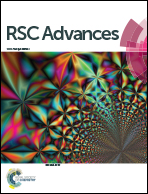Ascorbic acid-coated Fe3O4 nanoparticles as a novel heterogeneous catalyst of persulfate for improving the degradation of 2,4-dichlorophenol†
Abstract
Magnetic nanoscaled ascorbic acid/magnetite (H2A/Fe3O4) composite was prepared by oxidative polymerization and proposed as a novel heterogeneous catalyst of persulfate (PS) for improved degradation of 2,4-dichlorophenol (2,4-DCP). The composite was fully characterized and evaluated in terms of catalytic activity, effect of reaction parameters, iron ion leaching, and identification of primary reaction oxidants, as well as the possible role of H2A. The degradation efficiency of 2,4-DCP reached 98.5% within 150 min using the H2A/Fe3O4 nanocomposite compared with only 35.1% under the same conditions for pure nano Fe3O4. This result indicated an enhancement in the performance of activated PS. The findings of this study provide some new insights into the potential of using H2A to enhance the performance of Fe3O4 nanoparticles in the activation of PS for improving the degradation of organic pollutants.


 Please wait while we load your content...
Please wait while we load your content...